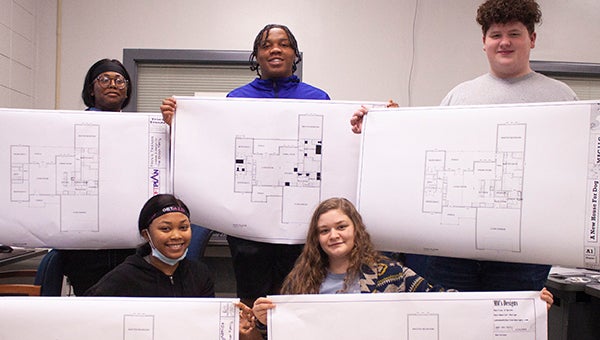Area high schoolers learn residential drafting in architectural design course
Published 10:38 am Thursday, March 31, 2022

- The students show off their home designs in the Residential Design and Building Information Modeling course. From the back left: Trinitee Odom, Dylan Wallace and Owen McCardle. From the front right, Adriana Carter and Marissa O'Quinn. (Photo by Ben Martin | The Vicksburg Post)
A group of high school students from the Vicksburg Warren School District are taking advantage of a new residential architectural design class offered through Hinds Community College.
The class is titled ‘Residential Design and Building Information Modeling,’ and is taught by instructor Richard Hunt. Hunt graduated from the University of Southern Mississippi with a degree in Architectural Engineering Technology.
“The idea is to teach them how to understand how a house goes together. We focus primarily on residential construction,” Hunt said. “[How to understand] the elements that have to be there, how to talk to the client and get the client’s needs, and translate that into the language of construction.”
Students are taught at the Hinds Community College facility which boasts brand new iMacs, 3D printers and a state-of-the-art plotter on which the students can hone their skills. They are currently learning how to use modeling software to create a home of their own design.
“So it’s basically virtual construction, right?” Hunt said. “The idea is, you design every aspect of the building details before you ever drive the first nail.”
The software the students are learning to use allows them to design a useable, detailed plan of the construction project.
“It’s able to print out materials lists, full specs, all that stuff,” Hunt said. “It can give you detailed cost estimates and things like that.”
The course isn’t just focused on architectural design. Hunt’s class is also learning about the business aspects of construction.
After getting his Bachelor’s degree, Hunt worked in the construction industry. Now he is trying to pass along the knowledge he wished he’d known before entering the field professionally.
“When I started out, I didn’t know what to charge people. I didn’t know how to talk to them about the money side of it,” Hunt said. “Teaching them how to grade that and be confident when talking about money to clients is a really important thing, too. I think that if they take nothing else away from (the course), being able to know their own value… and know the value of their work is one of the most important things I hope that they picked up in this class.”
Hunt said that the design process is a “moving experience.” He is trying to show the students that going from the sketch phase to the final design phase, and even on to the construction phase is a rewarding experience.
“When you see something that was in your mind, and you put it on a piece of paper,” he said. “And then someone builds it, and you see it for the first time in real life, It’s a ‘goosebumps moment.’”
Hunt said he is hopeful that the course will last past its first year, but he really needs it to grow in order to remain viable for the school district.
“Right now I’ve got five students,” he said. “I really have to have 10. So I need to get some interest from the students at-large to bring them in here.”
Hunt is also looking for support from the community.
“I actually have a few friends who are in the construction trades, and some real estate agents, a couple of developers that I’ve talked to, and they have all offered support,” he said.
According to Hunt, the reason for the interest from those types of professionals is “because it would benefit them… I’m trying to teach (the students) that they could do this right here. And that this could benefit this community directly,” he said.
Hunt thinks the course is a way for the students and the community to invest in a brighter economic future.
“There’s a housing shortage in this country,” Hunt said. “Getting your students started in the design-build process by learning about it is the first step of getting that corrected.”
Several students were confident that the skills they are learning in the course could be applied to their future careers.
Trinitee Odom, a senior, said this course is directly related to the fields she is interested in.
“It helped me learn that I actually want to be (in construction),” Odom said. “But I want to be an architect too; I want to do it all.”
Several students eagerly explained the architectural concept of ‘the work triangle,’ a general set of rules for laying out the floorplan in a space where work is performed (like a kitchen) to maximize the efficiency and ease of use of the person working.
Another student, Owen McCardle, said he was mostly interested in the artistic aspects of the course, and that the skills learned here are not only applicable to the fields of architecture and construction.
“Definitely take it. I mean, it’s not that you have to just take it because you want to be an architect,” McCardle said. “You could take it just to have some background knowledge on how some other things work.”
Hunt echoed the sentiment.
“You’ll learn something about construction, you learn something about design,” he said. “You’ll learn something about what it means to build a community and be part of a community (and how to) run a business.”





